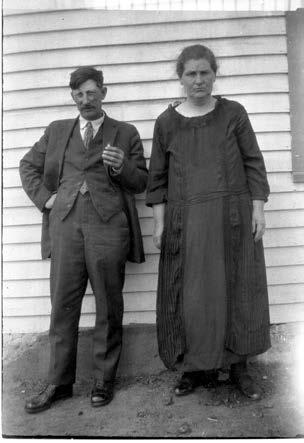
9 minute read
Nothing Will Change If Nothing Changes
Cover Image: Circus Dialogue by Michelle Lindblom, 24X18 monotype
By Kjersten Nelson
Advertisement
In 1893, Laura Eisenhuth was elected as North Dakota’s Superintendent of Public Instruction. There be may very little of note about this particular seat in this particular year except for one thing—Ms. Eisenhuth became the first female elected to a statewide office in the United States. Almost twenty years before women even earned a constitutional right to vote, Ms. Eisenhuth broke the barrier of statewide elected office for American women. In 1933, another North Dakota legislator, Minnie Craig, was elected as the first female Speaker of the House in the country.
Gains came in other elective offices as well. By the late 1970s, North Dakota ranked 11 out of 50 states in terms of the proportion of the state legislature that was female. Granted, the number of women in the legislature was a mere 13 percent, but compared to other states, North Dakota was notable. Within the legislature, women were reaching new leadership heights. During her tenure in the early 1980s, Representative Tish Kelly was the only female Speaker of the House in the country. North Dakota appeared poised to be a leader in women’s representation.
Unfortunately, those gains slowed significantly. By the early 1980s, the state’s rank dropped to twenty-ninth; by 2003, we were ranked forty-fourth, where we have largely remained. As of 2011, North Dakota ranks forty-fifth in the nation for women in the state legislature. Perhaps more striking is that the actual percentage—14.9 percent—is not much higher than the percentage in 1977 (12.4 percent). While the numbers fluctuated within this time period, women have lost ground in the state legislature.
It is helpful to place North Dakota’s underrepresentation problem in a larger context. The United States, as a whole, has seen sudden gains in terms of women’s representation, often followed by stagnation or losses. Typically considered a response to the Anita Hill–Clarence Thomas hearings, women flooded congressional races in 1992. The number of women in the United States Congress jumped from 32 in the 102nd Congress to 54 the following year. There was no corresponding jump in North Dakota during this time; in fact, this is precisely the point where the state’s ranking started to drop.
The same cannot be said for our neighboring states. Minnesota currently ranks fifth in the nation for the proportion of women in its state legislature (31 percent). Montana is twenty-third in the nation (24 percent), and South Dakota is twenty-seventh (20 percent).
To be sure, this representation problem exists elsewhere. Women make up a little over 50 percent of the population but only occupy 41 percent of the seats in Colorado’s state legislature (which ranks first). As a country, we rank seventy-first in the world, far behind other countries like Rwanda (first) and Canada (thirty-ninth). Nevertheless, in a context of underrepresentation of women, North Dakota falls within the bottom 10 percent.
Talking about this underrepresentation as a problem, in and of itself, contradicts many of our current beliefs about the way things should be. Many of us have internalized egalitarian beliefs about gender. The logical extension of these egalitarian beliefs is that gender should not matter. In other words, male or female, leadership is about the individual, not the social groups with which that person identifies.
In a perfect world, this might be true. However, the reality is that gender socializes us in important ways. Psychologists have found that when children are babies, daughters are more quickly warned to “be careful” than are sons. Psychologist Heidi Grant Halvorson reports that girls tend to get praised for completing tasks well, while boys tend to get rewarded for “trying hard.” This adds to other social messages that encourage boys to be risk takers. In a recent study, North Dakota State University student Maia Randklev finds that middle school health text books continue to send boys and girls different messages about sex: boys are encouraged to “wait to have sex,” while girls are told “to wait until after marriage.” More generally, studies document that up until middle school, boys and girls experience similar levels of self-confidence; in middle school, however, girls’ self-confidence drops precipitously.
The fact is that gendered messages might socialize us to think differently about what leadership should look like and what kinds of problems are important for our society to address. Research on leaders—both business and political —suggests that women tend to have a more collaborative approach, focusing on things like consensus-building. Given the rancorous state of our politics, many Americans might welcome this focus.
Other studies have found that, once elected, women tend to focus on different areas of policy. Political scientist Michele Swers finds that Democratic and moderate Republican women are more likely to introduce legislation in the United States Congress regarding issues like domestic violence, reproductive rights, and child care. While these types of issues are typically framed as “women’s issues,” they are issues that affect all of us in our homes and our communities. Perhaps Congresswoman Barbara Kennelly (Connecticut) sums it up best when she says, “Women have a different perspective and you need women to be in the room to make sure it is heard.”
There is little that stands in the way, legally, of women being fully involved in politics. And in some respects, they are. Women vote at equal or higher rates than men, fight for issues, organize, and discuss politics. Something happens, though, when it comes to running for office. It’s not that people won’t vote for them. That used to be the case. But currently, when women run, women win at rates equal to men. So what is going on?
One early explanation centered on the idea of a “pipeline”—that is, for men, certain professions tend to feed into politics; law and business being the largest contributors. There was great hope that as more women entered these professions, they would also start to move towards politics in equal proportions. This expectation, however, was not realized.
Scholars then turned their attention to more personal factors that may influence women’s participation. Women continue to bear the weight of responsibility for child care and housework. Serving in the legislature means weeks away from home, not to mention the grueling campaign schedule that leads up to it. The research has found that one impact of this reality is that women who run tend to do so later in life, after their children have grown.
Family responsibilities, then, are part of the story but cannot explain the dearth of female candidates. Jennifer Lawless and Richard Fox, two political scientists, identified a sample of men and women who were professionals in those careers that most often contribute candidates for public office. Through surveys and interviews, they discovered that women tend to underestimate their abilities. If you could find a man and woman who were identical in terms of their qualifications and experience, it is far more likely that the man would say he was qualified to hold office while the woman would not. Subsequently, women were also more likely to say that the anticipated negativity of a campaign was enough to dissuade them from running—women were more likely to doubt that they had “thick enough skin” to endure a political campaign.
Finally, Fox and Lawless also find that one of the major reasons that women don’t run is because nobody asks! This is true of friends, family members, colleagues, but, most relevantly, party officials. Between the genders, men were more likely to report that someone had asked them to consider running for office. As elected women I have spoken with explained, they needed someone to ask—again and again—for this career path to even start seeming like a possibility.
Women’s underrepresentation in elected office is a complex issue. It appears to be an imperfectly understood nexus of personal, sociological, and psychological factors. The good news is that this research also suggests some obvious steps in recruiting more women and systematically bringing this perspective more prominently into the legislative arena. The first suggestion is one that I have recently tried to incorporate more into my own life—that is, when we see impressive women doing impressive things, we can ask them if they have ever considered running for office. I have started doing this with my students. For some, this is clearly the first time they thought about running. But one female student stands out in my mind—when I asked if she had ever considered running for office, her face lit up. She poured forth the issues she was interested in. I like to think that this suggestion added legitimacy to her personal goals—someone else recognized that she had this potential. And remember, there really is no risk in asking others to consider this. The worst they do is say no. Even when they say no, it is possible you have planted a seed.
Parties—or well-positioned individuals within the parties—also need to make this a priority. Minnesota offers a prime example of how this might work. Now one of the exemplars of women’s representation, the state had been miserable in the rankings. At one point, though, a well-placed woman in the DFL headed up a candidate-recruitment committee that only recruited female candidates. Without that woman’s willingness to take a stance and use her institutional power, it is unclear where Minnesota would stand today.
To address the lack of confidence, the North Dakota Women’s Network (NDWN) is sponsoring several sessions of Ready to Run, a day-long conference that brings together potential candidates with accomplished female candidates and campaign experts. The seminar provides nuts-and-bolts information about running for office but, perhaps more importantly, provides a connection with women who have succeeded in electoral politics. I have heard from more than one female elected official that they pursued their position because they had a group of dedicated, female volunteers who believed in them and stood behind them all the way. While women can build up these networks on their own, organizations like NDWN can help facilitate this community-building.
Another way that nonprofit organizations can help women overcome this lack of confidence is by putting women in contact with current elected legislators as much as possible. One of the great things about North Dakota politics is that we have a citizen legislature—the purest form of democracy, where ordinary citizens head to Bismarck to represent North Dakotans. Non-profits can help break down this feeling that legislators are inaccessible or threatening by bringing ordinary women into contact with legislators as often as possible. There is no one recipe for what got our representatives there. There is a diversity of educations, careers, and personal backgrounds. The more women interact with legislators, the more women will realize: I can do this.
In sum, the issue of women’s underrepresentation is a complicated one with personal, psychological, and sociological factors contributing to this outcome. As with most complicated social issues, though, change can—and must—start with us.
So, how about you? Ever thought about running for office…?
Kjersten Nelson is an assistant professor of political science at North Dakota State University. Her research focuses on women’s involvement in politics and citizen perceptions of those women. She lives in Fargo with her family.








